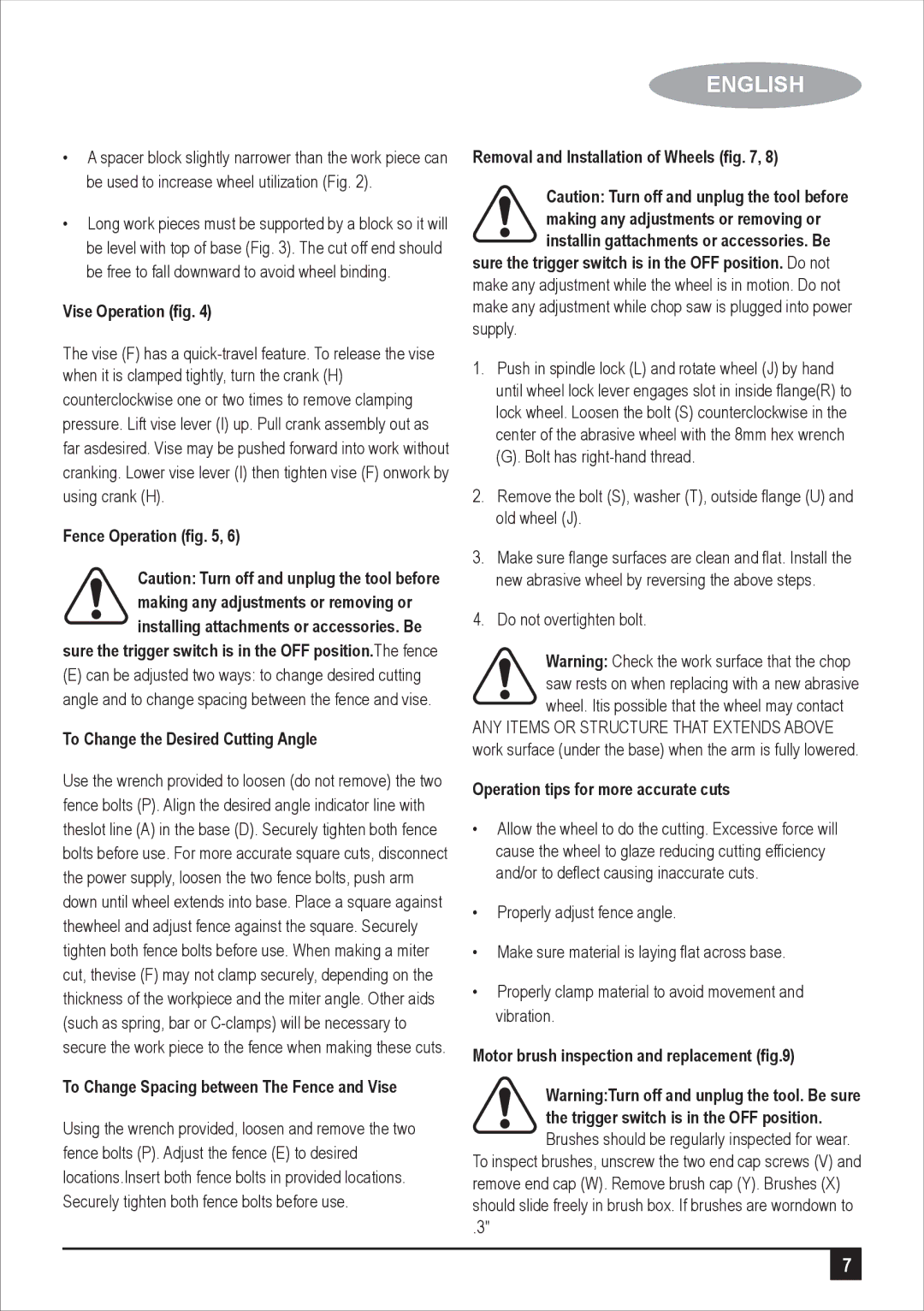
ENGLISH
•A spacer block slightly narrower than the work piece can be used to increase wheel utilization (Fig. 2).
•Long work pieces must be supported by a block so it will be level with top of base (Fig. 3). The cut off end should be free to fall downward to avoid wheel binding.
Vise Operation (fig. 4)
The vise (F) has a
Fence Operation (fig. 5, 6)
Caution: Turn off and unplug the tool before making any adjustments or removing or installing attachments or accessories. Be
sure the trigger switch is in the OFF position.The fence
(E)can be adjusted two ways: to change desired cutting angle and to change spacing between the fence and vise.
To Change the Desired Cutting Angle
Use the wrench provided to loosen (do not remove) the two fence bolts (P). Align the desired angle indicator line with theslot line (A) in the base (D). Securely tighten both fence bolts before use. For more accurate square cuts, disconnect the power supply, loosen the two fence bolts, push arm down until wheel extends into base. Place a square against thewheel and adjust fence against the square. Securely tighten both fence bolts before use. When making a miter cut, thevise (F) may not clamp securely, depending on the thickness of the workpiece and the miter angle. Other aids (such as spring, bar or
To Change Spacing between The Fence and Vise
Using the wrench provided, loosen and remove the two fence bolts (P). Adjust the fence (E) to desired locations.Insert both fence bolts in provided locations. Securely tighten both fence bolts before use.
Removal and Installation of Wheels (fig. 7, 8)
Caution: Turn off and unplug the tool before making any adjustments or removing or
![]() installin gattachments or accessories. Be sure the trigger switch is in the OFF position. Do not make any adjustment while the wheel is in motion. Do not make any adjustment while chop saw is plugged into power supply.
installin gattachments or accessories. Be sure the trigger switch is in the OFF position. Do not make any adjustment while the wheel is in motion. Do not make any adjustment while chop saw is plugged into power supply.
1.Push in spindle lock (L) and rotate wheel (J) by hand until wheel lock lever engages slot in inside flange(R) to lock wheel. Loosen the bolt (S) counterclockwise in the center of the abrasive wheel with the 8mm hex wrench
(G). Bolt has
2.Remove the bolt (S), washer (T), outside flange (U) and old wheel (J).
3.Make sure flange surfaces are clean and flat. Install the new abrasive wheel by reversing the above steps.
4.Do not overtighten bolt.
Warning: Check the work surface that the chop saw rests on when replacing with a new abrasive wheel. Itis possible that the wheel may contact
ANY ITEMS OR STRUCTURE THAT EXTENDS ABOVE work surface (under the base) when the arm is fully lowered.
Operation tips for more accurate cuts
•Allow the wheel to do the cutting. Excessive force will cause the wheel to glaze reducing cutting efficiency and/or to deflect causing inaccurate cuts.
•Properly adjust fence angle.
•Make sure material is laying flat across base.
•Properly clamp material to avoid movement and vibration.
Motor brush inspection and replacement (fig.9)
Warning:Turn off and unplug the tool. Be sure the trigger switch is in the OFF position.
Brushes should be regularly inspected for wear. To inspect brushes, unscrew the two end cap screws (V) and remove end cap (W). Remove brush cap (Y). Brushes (X) should slide freely in brush box. If brushes are worndown to
.3"
7
